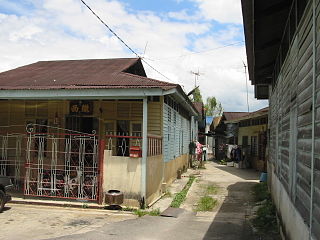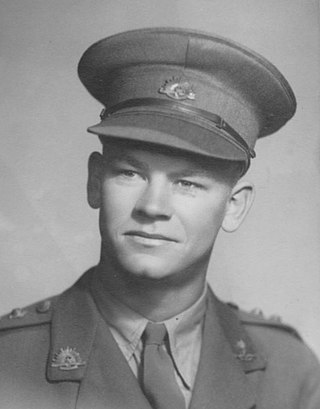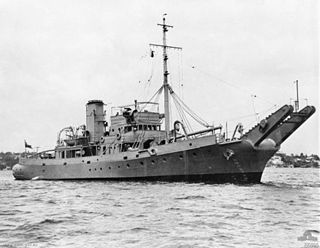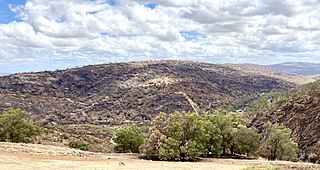
Western Australia (WA) is the westernmost state of Australia. It is bounded by the Indian Ocean to the north and west, the Southern Ocean to the south, the Northern Territory to the north-east, and South Australia to the south-east. Western Australia is Australia's largest state, with a land area of 2,527,013 square kilometres (975,685 sq mi), and is also the second-largest subdivision of any country on Earth, surpassed only by the Sakha Republic in eastern Russia, and formerly Northwest Territories in Canada, before the creation of Nunavut. It is also the largest proper subnational entity, being a state rather than a territory or an autonomous region.

Thomas Leslie "Jack" Axford, was an Australian recipient of the Victoria Cross, the highest award for gallantry in the face of the enemy awarded to British and Commonwealth forces.

Western Australia (WA) is divided into regions according to a number of systems.

New villages, also known as Chinese new villages, were internment camps created during the waning days of British rule in Malaysia. They were originally created as part of the Briggs Plan, first implemented in 1950, to isolate guerillas from their supporters within the rural civilian populations during the Malayan Emergency. Most were surrounded by barbed wire and watchtowers to stop people from escaping, with guards being ordered to kill anyone who attempted to leave outside of curfew hours.
This article lists important figures and events in Malayan public affairs during the year 1950, together with births and deaths of significant Malayans.

The Western Mail, or Western Mail, was the name of two weekly newspapers published in Perth, Western Australia.

Forrest Highway is a 95-kilometre-long (59 mi) highway in Western Australia's Peel and South West regions, extending Perth's Kwinana Freeway from east of Mandurah down to Bunbury. Old Coast Road was the original Mandurah–Bunbury route, dating back to the 1840s. Part of that road, and the Australind Bypass around Australind and Eaton, were subsumed by Forrest Highway. The highway begins at Kwinana Freeway's southern terminus in Ravenswood, continues around the Peel Inlet to Lake Clifton, and heads south to finish at Bunbury's Eelup Roundabout. There are a number of at-grade intersections with minor roads in the shires of Murray, Waroona, and Harvey including Greenlands Road and Old Bunbury Road, both of which connect to South Western Highway near Pinjarra.

William Leonard Grayden is an Australian former politician. He was a member of parliament across six decades, serving in the Western Australian Legislative Assembly and the Australian House of Representatives (1949–1954). A World War II veteran, he served as a Liberal with the exception of a brief period as an independent. Grayden was a backbencher in federal parliament, but later held ministerial office in the state government of Charles Court. His brother David and grandfather Nat Harper were also members of parliament.

HMAS Karangi was a Kangaroo-class boom defence vessel operated by the Royal Australian Navy (RAN) during World War II. The third of three ships constructed by the Cockatoo Docks and Engineering Company at Cockatoo Island Dockyard based on the British Bar-class, Karangi was launched on 16 August 1941. After the war, the ship remained in active service with the RAN and played a small but key role in the British nuclear testing program. She was placed in reserve in 1953. In 1955, Karangi was reactivated and served for another two years until May 1957 and was eventually sold for scrap in 1966.

During the summer of 2010–11, a relative lack of bushfires occurred along Eastern Australia due to a very strong La Niña effect, which instead contributed to severe flooding, in particular the 2010–11 Queensland floods and the 2011 Victorian floods. As a result of these weather patterns, most major fire events took place in Western Australia and South Australia. Some later significant fire activity occurred in Gippsland in eastern Victoria, an area which largely missed the rainfall that lead to the flooding in other parts of the state.

The Western Australian Ice Hockey Association, currently trading as Ice Hockey Western Australia is the governing body of ice hockey in Western Australia. Ice Hockey WA is a branch of Ice Hockey Australia.
Australian involvement in the Malayan Emergency lasted 13 years, between 1950 and 1963, with army, air force and naval units serving. The Malayan Emergency was a guerrilla war fought between Commonwealth armed forces and the Malayan National Liberation Army (MNLA), the military arm of the Malayan Communist Party, from 1948 to 1960 in Malaya. The Malayan Emergency was the longest continuous military commitment in Australia's history. Thirty-nine Australians were killed and 27 wounded.

Southern Rhodesia, then a self-governing colony of the United Kingdom, sent two military units to fight with the Commonwealth armed forces in the Malayan Emergency of 1948–60, which pitted the Commonwealth against the Malayan National Liberation Army (MNLA), the military arm of the Malayan Communist Party. For two years, starting in March 1951, white Southern Rhodesian volunteers made up "C" Squadron of the Special Air Service (SAS). The Rhodesian African Rifles, in which black rank-and-filers and warrant officers were led by white officers, then served in Malaya from 1956 to 1958.
The Sungai Siput incident marked the beginning of the Malayan Emergency on 16 June 1948. Three European plantation managers were killed at Sungai Siput, Perak in two different rubber estates – the Elphil estate and Phin Soon estate. The estates were two kilometres apart.
The Penang ambush was an incident that took place during the Malayan Emergency. Communists ambushed Malayan and British police and killed eight of them, including a British police sergeant.
Operation Termite took place during the Malayan Emergency. It involved extensive attacks on communist camps, dropping over 200 British troops into the jungle. Communist casualties were low but many camps were destroyed.

The 2021 Wooroloo bushfire was a fast moving bushfire that started on 1 February in Wooroloo, 45 kilometres (28 mi) north-east of the Perth central business district, in the Shire of Mundaring, Western Australia. By 2 February, the bushfire emergency had spread to Shires of Chittering and Northam, and the City of Swan. It had destroyed at least 86 houses and 2 fire trucks. By 6 February, the bushfire had travelled 26 km (16 mi) from its source. The fire coincided with a five day lockdown of the Perth metropolitan region that started at 6pm on 31 January, due to a case of COVID-19 outside of hotel quarantine. In July 2021, WA Police charged a man with a breach of duty and carrying out an activity that could cause a fire, alleging that he used an angle grinder that caused sparks.

The COVID-19 pandemic in Western Australia is part of the ongoing worldwide pandemic caused by severe acute respiratory syndrome coronavirus 2. Western Australia (WA) confirmed its first case of COVID-19 on 21 February 2020, and its first death on 1 March. On 15 March, premier Mark McGowan declared a state of emergency. On 24 March, Western Australia closed its borders to the rest of Australia, and on 1 April, the state implemented borders between regions in the state. By mid-April 2020, the state had eliminated community transmission of COVID-19, becoming one of the few places in the world to do so. There were only a handful of cases of community transmission in the state after mid-April, until late December 2021 when a tourist caused an outbreak that led to the cancelling of some New Year's Eve events, and the re-imposing of mask wearing rules in Perth and the Peel region.
The 2021–22 Australian bushfire season was the season of summer bushfires in Australia. The outlook for the season was below average in parts of Eastern Australia thanks to a La Niña, with elevated fire danger in Western Australia. Higher than normal winter rainfall has resulted in above average to average stream flows and soil moisture levels through much of eastern Australia. The outlook to the end of spring was also for above average falls over much of the country apart for Western Australia. The Australian Capital Territory, Victoria and southern New South Wales are expected to have a below normal fire potential as a result of vegetation still recovering from the 2020–21 Australian bushfire season. Areas of south eastern Queensland, northern New South Wales and northern Western Australia expect an above normal fire potential caused by crop and grass growth in these areas.
The 2021 Beechina bushfire was a bushfire that began on 26 December 2021 in Beechina, 46 kilometres east-north-east of the Perth central business district, in the Shire of Mundaring, Western Australia. The bushfire began less than five kilometres from the 2021 Wooroloo bushfire, and coincided with a COVID-19 outbreak and associated public health measures in the Perth metropolitan region. One house was destroyed as a result of the fire, along with six outbuildings and a number of vehicles.















